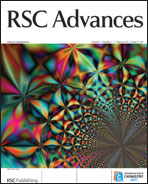As shown in the literature, many methods have been developed to improve the signal, reproducibility and stability of surface-enhanced Raman scattering (SERS) for its reliable application. However, the fabrication needed is laborious. In this work, we propose an effective method to prepare SERS-active substrates with Ag nanoparticles (NPs) by a new electrochemical strategy of deposition–dissolution cycles (DDCs). This electrochemical method is based on a cathodic potential of 0.25 V and an anodic potential of 1.05 V vs.Ag/AgCl, which are applied in turn under sonication. The prepared SERS-active substrate demonstrates a large Raman scattering enhancement for adsorbed Rhodamine 6G (R6G). The practical detection limit for polypyrrole deposited on this substrate is 0.1 μC cm−2. Moreover, the prepared SERS-active substrates exhibit satisfactory reproducibility and thermal stability. The SERS spectrum of R6G on the newly developed substrate still performs well at a high temperature of 250 °C.

You have access to this article
 Please wait while we load your content...
Something went wrong. Try again?
Please wait while we load your content...
Something went wrong. Try again?


 Please wait while we load your content...
Please wait while we load your content...